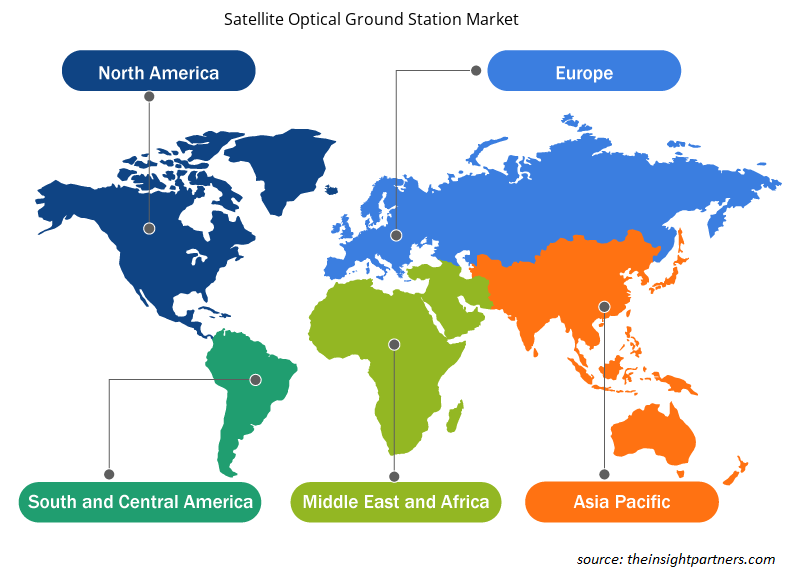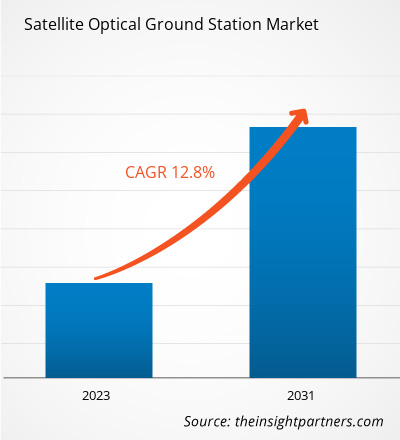卫星光学地面站市场规模预计将从 2023 年的 620.1392 亿美元增至 2031 年的 1625.406 亿美元。全球新机场建设的增加推动了对通信网络解决方案的需求。全球卫星发射数量的增加刺激了对光学地面站的需求,以跟踪和监测卫星的运动并同时接收和传输数据。此外,先进的 OGS 也因其在监测这些卫星方面的帮助而获得了需求。此外,对 OGS 的需求正在推动避免空间碎片与功能性空间资产相撞的威胁。OGS 还有助于确保符合国内和国际准则、标准和其他规范的安全和可持续的空间活动。
卫星光学地面站市场分析
由于对地观测、通信和导航以及科学研究等各种应用对卫星的需求不断增加,全球卫星发射次数正在增加。据几家航天机构称,2012-2021 年期间,平均每年发射约 466 颗小型卫星,预计 2022-2031 年期间每年将发射 1,846 颗小型卫星。为了在 2012-2021 年发射这 4,663 颗小型卫星,各国政府和公司投资了约 231 亿美元,预计 2022-2031 年期间将进一步投资 840 亿美元。此外,主要用于在太空部署卫星的太空火箭发射次数也在迅速增加。 2021 年,火箭发射成功 136 次,而 2022 年,这一数字上升到 180 次。2022 年 9 月,共进行了 16 次轨道发射,其中 8 次在中国进行,6 次在美洲进行,欧洲和俄罗斯各进行了一次。此外,猎鹰 9 号发射了 191 颗 Starlink 宽带卫星,SpaceX 在 2022 年发射了 1,465 颗 Starlink 卫星。同样,在 2023 年 1 月,中国从中国北部山西省太原卫星发射中心用长征二号丁运载火箭发射了 14 颗卫星。这 14 颗卫星包括齐鲁二号和齐鲁三号、珞珈三号 01 号和吉林一号高分 03D34 号。2023 年 2 月,印度空间研究组织 (ISRO) 宣布通过 SSLV-D2 运载火箭成功将三颗卫星部署到预定轨道。
卫星光学地面站市场概览
光学地面站 (OGS) 是连接太空和地面的基础设施的重要组成部分。该系统有助于为各种应用提供实时通信,数据速率远高于 RF(高达几 Gbps)。科学家需要详细观察地球和太阳系,因此对高分辨率数据的需求日益增加,这导致了对 OGS 系统的需求旺盛。该系统还有助于提供大量数据以满足任务要求并定位与任务轨道参数相关的地面资产。因此,全球对 OGS 的需求正在增加,以实现更准确和高速的数据传输。
定制此报告以满足您的需求
您可以免费定制任何报告,包括本报告的部分内容、国家级分析、Excel 数据包,以及为初创企业和大学提供优惠和折扣
- 获取此报告的关键市场趋势。这个免费样品将包括数据分析,从市场趋势到估计和预测。
卫星光学地面站市场驱动因素和机遇
太空垃圾数量不断增加
所有在不同高度绕地球运行的非功能性人造材料都可以称为空间垃圾。垃圾包括火箭机身部件、碎片、载人飞行任务产生的垃圾、火箭尾气和报废卫星。大多数此类碎片在低地球轨道 (LEO) 上以平均每小时 26,000 公里以上的速度绕地球运行,对功能性太空资产构成严重的碰撞威胁。这种威胁随着每次向低地球轨道和深空发射火箭而增加。空间物体碰撞威胁的增加一直是安全和可持续利用外层空间的一个问题。这些威胁限制了不受阻碍地进入太空,并促使有关方面采取必要措施降低风险。2021 年 11 月,俄罗斯军方进行了反卫星试验 (ASAT),并用 Nudol 导弹炸毁了其已报废的 Cosmos 1408 卫星(该卫星于 1982 年发射)。爆炸发生后,国际空间站上的美国和俄罗斯宇航员必须立即采取预防措施,以免被卫星碎片击中,因为国际空间站距离卫星相当近。2022 年 6 月,国际空间站再次不得不进行防撞机动 (CAM),以避开被毁卫星的轨道碎片。俄罗斯航天局 Roscosmos 使用一艘无人驾驶的“进步 81”号货运飞船将空间站从碎片路径上移开。2021 年,印度空间研究组织进行了 19 次 CAM,而 2020 年和 2019 年分别进行了 12 次和 8 次 CAM。
战略联盟数量不断增加
卫星光学地面站需求的不断增长,促使企业为航天工业的扩张开发先进的解决方案。为了实现这一扩张,不同国家的政府和各个垂直行业的利益相关者都在不断投资研发。他们更喜欢各种战略联盟,如伙伴关系、合作关系和合同,下面提到了其中一些:
• 2023 年 3 月,CONTEC 宣布已选择 Cailabs 提供光学地面站,该地面站将于 2024 年安装。这个新的光学地面站将采用 TILBA-ATMO 组件,实现可靠的高速通信。此外,地面站将具备 CCSDS、SDA 和 QKD 功能。
• 2023 年 2 月,卢旺达航天局 (RSA) 宣布与 ATLAS Space Operations Inc. 合作,在卢旺达建设卫星地面基础设施。根据该协议,RSA 正在建设一个能够容纳多个地面站的卫星港,为不同轨道上的卫星提供服务。
• 2022 年 9 月,赛峰数据系统公司宣布已与 CONTEC 签订合同,交付将安装在西澳大利亚的光学地面站。赛峰将交付一个交钥匙光学地面站 (OGS),该站将包括一个提供最佳覆盖范围的支架;一个 50 厘米望远镜;一个完整的指向、采集和跟踪系统;以及一个旋转圆顶。
• 2022 年 9 月,SSC 宣布欧洲航天局 (ESA) 授予其一份价值 109 万美元(110 万欧元)的合同,以支持光通信项目“从太空向地球传输数据的光学站网络 (NODES)”的开发。根据这份合同,SSC 与 Cailabs 签订了订单,将在西澳大利亚交付一个地面站,计划于 2024 年初开始试验。
因此,通过合同和合作伙伴关系,各公司正在致力于提供先进的光学地面站,预计这将在预测期内为卫星光学地面站市场提供潜在的增长机会。
卫星光学地面站市场报告细分分析
有助于得出卫星光学地面站市场分析的关键部分是运营、应用、最终用户和设备。
- 根据运营情况,卫星光学地面站市场分为激光卫星通信和光学运营。解决方案包括 Smartsky 网络、Iridium 网络、SITA connect 和 AirportHub 等软件。光学运营部门在 2023 年占据了最大的市场份额。
- 根据应用,卫星光学地面站市场细分为激光操作、碎片识别、地球观测和空间态势感知。地球观测部分在 2023 年占据了更大的市场份额。
- 根据最终用户,卫星光学地面站市场分为政府、军事和商业企业。政府和军事部门在 2023 年占据了更大的市场份额。
- 按设备划分,卫星光学地面站市场分为消费设备和网络设备。网络设备部门在 2023 年占据了更大的市场份额。
卫星光学地面站市场份额按地区分析
北美卫星光学地面站市场分为美国和加拿大。美国和加拿大正在广泛采用先进的卫星光学地面站技术来提高国防能力。2020 年 8 月,美国航天中心宣布联合发射联盟 (ULA) 被授予为美国太空部队发射关键国家安全太空任务的合同。这些任务计划于 2027 财年从佛罗里达州卡纳维拉尔角空军基地部署。这些类型的卫星发射有助于采用地面站技术。
此外,整个地区新卫星地面站的启动和现有地面站的扩建是推动北美地区卫星光学地面站增长的其他主要因素。例如:
• 2022 年,BlueHalo 赢得了美国太空军价值 14 亿美元的合同,用于升级全国 12 个军事地面站,其中 BlueHalo 将用电子相控阵天线取代军事地面站上的旧式抛物面卫星天线。
• 2023 年 2 月,卫星运营商 KSAT 宣布将通过在南极洲安装新的地面站天线来扩展其网络,并通过在夏威夷、阿拉斯加和美国东南部安装多个天线来扩大其在美国网络的容量。
• 2023 年 1 月,SpaceX 的 Starlink 宣布发射第二代卫星群,并在美国各地扩展其地面站基础设施。
• 2019 年 5 月,Ultra Electronics Communications & Integrated Systems (CIS) 旗下的 GigaSat 与 Inmarsat 合作,向加拿大国防部 (DND) 交付了 16 个卫星多频段地面站终端。
这些发展可能会促进该地区卫星地面站的发展。此外,卫星发射数量的增长也是另一个可能在预测期内为市场供应商创造新机会的主要因素。
卫星光学地面站市场区域洞察
Insight Partners 的分析师已详尽解释了预测期内影响卫星光学地面站市场的区域趋势和因素。本节还讨论了北美洲、欧洲、亚太地区、中东和非洲以及南美洲和中美洲的卫星光学地面站市场细分和地理位置。

- 获取卫星光学地面站市场的区域特定数据
卫星光学地面站市场报告范围
| 报告属性 | 细节 |
|---|---|
| 2023 年的市场规模 | 620.1392亿美元 |
| 2031 年市场规模 | 1625.406 亿美元 |
| 全球复合年增长率(2023 - 2031) | 12.8% |
| 史料 | 2021-2022 |
| 预测期 | 2023-2031 |
| 涵盖的领域 | 按操作
|
| 覆盖地区和国家 | 北美
|
| 市场领导者和主要公司简介 |
|
市场参与者密度:了解其对商业动态的影响
卫星光学地面站市场正在快速增长,这得益于终端用户需求的不断增长,这些需求源于消费者偏好的不断变化、技术进步以及对产品优势的认识不断提高等因素。随着需求的增加,企业正在扩大其产品范围,进行创新以满足消费者的需求,并利用新兴趋势,从而进一步推动市场增长。
市场参与者密度是指在特定市场或行业内运营的企业或公司的分布情况。它表明相对于给定市场空间的规模或总市场价值,有多少竞争对手(市场参与者)存在于该市场空间中。
在卫星光学地面站市场运营的主要公司有:
- 泰雷兹公司
- 鲍尔公司
- AAC克莱德空间公司
- 亨索尔特公司
- 通用原子航空系统公司
- Tesat-Spacecom 有限公司
免责声明:上面列出的公司没有按照任何特定顺序排列。

- 了解卫星光学地面站市场顶级关键参与者概况
卫星光学地面站市场新闻和最新发展
卫星光学地面站市场通过收集一手和二手研究后的定性和定量数据进行评估,其中包括重要的公司出版物、协会数据和数据库。以下是市场创新、业务扩展和战略发展情况的列表:
- 2023 年 4 月,欧洲国防工业领先企业 HENSOLDT AG 晋升为法兰克福证券交易所中型股指数 MDAX。该公司于 2020 年 9 月上市,始终坚持增长路线,不断增强创新实力。它增加了投资,扩大了产品组合,并在全球范围内进行了战略收购。(来源:HENSOLDT AG,新闻稿)
- 2023 年 4 月,Ball Aerospace、Loft Federal 和微软联手开展美国太空发展局 (SDA) 的实验测试平台计划 NExT,将 10 颗载有实验有效载荷的卫星送入轨道。Ball Aerospace 是主要承包商,负责有效载荷和航天器的集成和测试。Loft Federal 将执行航天器的集成和测试、采购商业发射服务并在轨道上运营卫星群。同时,微软将为 Azure 政府云和地面站基础设施提供安全的卫星发射后运营和生产力解决方案,以推动关键任务通信。此次合作旨在建立一条与供应商无关的快速交付渠道,以确保 SDA 的任务成功。(来源:Ball Aerospace,新闻稿)
卫星光学地面站市场报告范围和交付成果
“卫星光学地面站市场规模和预测(2021-2031年)”报告对市场进行了详细的分析,涵盖以下领域:
- 范围内涵盖的所有主要细分市场的全球、区域和国家层面的卫星光学地面站市场规模及预测。
- 市场动态,如驱动因素、限制因素和关键机遇
- 卫星光学地面站市场趋势
- 详细的 PEST/波特五力分析和 SWOT 分析
- 卫星光学地面站市场分析涵盖主要市场趋势、全球和区域框架、主要参与者、法规和最新市场发展
- 卫星光学地面站市场格局和竞争分析,包括市场集中度、热图分析、知名参与者和最新发展。
- 详细的公司简介
- 历史分析(2 年)、基准年、预测(7 年)及复合年增长率
- PEST和SWOT分析
- 市场规模、价值/数量 - 全球、区域、国家
- 行业和竞争格局
- Excel 数据集
近期报告
客户评价
购买理由
- 明智的决策
- 了解市场动态
- 竞争分析
- 客户洞察
- 市场预测
- 风险规避
- 战略规划
- 投资论证
- 识别新兴市场
- 优化营销策略
- 提升运营效率
- 顺应监管趋势





















 获取免费样品 - 卫星光学地面站市场
获取免费样品 - 卫星光学地面站市场